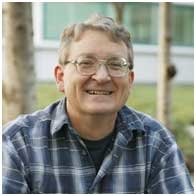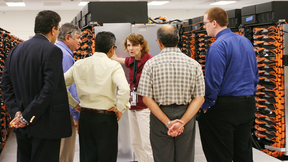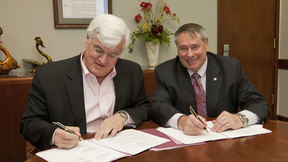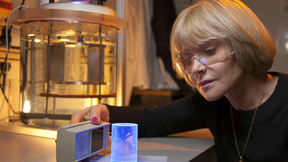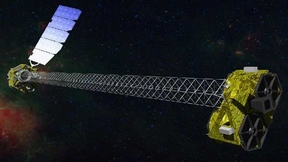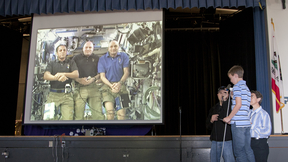Back
The Laboratory has a starring role in an upcoming National Geographic documentary about the sinking of the British passenger ship Lusitania during the early part of World War I.On May 7, 1915, prior to the U.S. entry into the war, a single, well-placed German torpedo struck the RMS Lusitania passenger liner with 1,959 passengers on board, en route from New York to…
Stephen Klein, a climate scientist working in the Program for Climate Model Diagnosis and Intercomparison, has been awarded the American Geophysical Union (AGU) Atmospheric Sciences Section's Ascent Award. The AGU is recognizing Klein's research "elucidating the role of clouds in climate change and the fidelity with which climate models simulate clouds." As a specialist in…
Gold isn't just for wedding bands anymore. D espite its reputation as an inert material, nanostructured gold is a very promising candidate as a catalyst, optic, sensor, energy harvester as well as an energy storer. The Laboratory's Juergen Biener and Arne Wittstock and colleagues have explored the field by editing a Royal Society of Chemistry book "Nanoporous Gold: From an…
LIVERMORE, Calif. -- Many marine species will be harmed or won't survive if the levels of carbon dioxide continue to increase. Current protection policies and management practices are unlikely to be enough to save them. Unconventional, non-passive methods to conserve marine ecosystems need to be considered if various marine species are to survive. This is the conclusion of…
Two Laboratory biomedical scientists have recently been named fellows. Carolyn Hall and Dina Weilhammer both work in LLNL's Biosciences and Biotechnology Division. Hall, 34, a microbiologist and analyst with the Biodefense Knowledge Center (BKC), has been selected as a 2012-13 Fellow of the Emerging Leaders in Biosecurity Initiative. Weilhammer, 30, an immunologist, has…
Bioinformatics expert Tom Slezak is no stranger to the National Academy of Science (NAS), having served on two committees since 2009. Recently, he was asked to join a standing committee chartered by the Department of Defense (DoD) to advise the DoD on biodefense issues, a much broader scope than either of his previous committee mandates. The NAS in Washington, D.C., is the…
Lab researchers have discovered a new method to control the conductivity of materials that could eventually apply to fuel cells, batteries and gas sensors. Postdoc Cedric Rocha-Le?o, working with Condensed Matter and Materials Division's Vince Lordi, has found a new method to independently control ionic and electronic conductivities in certain solids. The method, which…
A team of DOE researchers from the Laboratory, Lawrence Berkeley and Los Alamos national laboratories and SLAC National Accelerator Laboratory, studying the fundamental properties of the actinide elements, has significantly advanced the understanding of the electronic structure of elements that have electrons occupying f-orbitals. Using a state-of-the-art, synchrotron…
By day, Heather Whitley is a design physicist studying transport processes in dense plasmas, such as those relevant to LLNL's National Ignition Facility. During evenings and on weekends, she dances and volunteers with Livermore's nonprofit ballet company, the Valley Dance Theatre. And she likes to get there in a hurry while driving her 2011 Camaro SS. Whitley, who turns 32…
Lawrence Livermore National Laboratory researchers have developed a new capacitive desalination technique that could ultimately lower the cost and time of desalinating seawater. In capacitive desalination (CD), a voltage is applied between two porous electrodes to adsorb ions onto the electrode surface and thus remove them from the feed stream. Traditionally, due to the…
To lay the foundation for stronger collaborations to address national energy problems, the Laboratory recently invited researchers from leading universities to exchange ideas and mathematical approaches for leveraging high performance computing, and to identify areas for cooperative research. "This exchange of ideas is a great opportunity to build on existing…
A far-reaching discovery about laser-matter interaction with important implications for the National Ignition Facility (NIF) has led to the selection of a team of researchers named recipients of the 2012 John Dawson Award for Excellence in Plasma Physics Research. The award, established by the American Physical Society, will be presented to LLNL researchers Debbie Callahan…
Lawrence Livermore National Laboratory (LLNL) and NASA's Ames Research Center (ARC) in Mountain View, Calif., have agreed to collaborate by sharing technology and resources on technical areas of national interest, including space missions, energy and advanced computing. LLNL director Parney Albright and ARC director Pete Worden signed the agreement Thursday in Livermore,…
For the first time, Lawrence Livermore researchers and international collaborators have peered into the makeup of complex airborne particulate matter so small that it can be transported into human lungs -- usually without a trace. The structure of micron-size particulate matter is important in a wide range of fields from toxicology to climate science (tobacco smoke and oil…
Lawrence Livermore National Laboratory researchers have won six awards for their efforts in developing breakthrough technologies with commercial potential. See video . R&D Magazine announced the winners of its annual R&D 100 Awards, sometimes called the "Oscars of Invention" on Wednesday. The awards will be presented Nov. 1 during a black-tie dinner at the SeaWorld…
For astrophysicist Bill Craig and his team, NASA's NuSTAR will open up a whole new world. In fact, NuSTAR will allow them to observe a new class of objects in space, called extreme objects, which have never been seen. The Nuclear Spectroscopic Telescope Array (or NuSTAR), is the first focusing, high energy X-ray NASA satellite that will open the hard X-ray sky for…
LLNL postdoc Frederic Perez is one of three recipients of this year's Ph.D. Research Award from the Plasma Physics Division of the European Physical Society (EPS). Perez will receive his award during the 39th EPS plasma physics conference, held in Stockholm, Sweden, on July 2-6. Perez received the award for his work on his doctoral thesis, "Study of supra-thermal electron…
LIVERMORE, Calif. -- The oceans have warmed in the past 50 years, but not by natural events alone. New research by a team of Lawrence Livermore National Laboratory scientists and international collaborators shows that the observed ocean warming over the last 50 years is consistent with climate models only if the models include the impacts of observed increases in…
Students at Livermore's Junction Avenue School had an opportunity that was "out of this world." They got the chance on Wednesday to talk with three astronauts via an in-flight education downlink from the International Space Station (ISS). The entire school's student body -- from kindergarten to 8th grade -- assembled in two locations to watch the videoconference. "What a…
LIVERMORE, Calif. -- Lawrence Livermore National Laboratory researchers have for the first time simulated and quantified the early stages of radiation damage that will occur in a given material. "A full understanding of the early stages of the radiation damage process provides knowledge and tools to manipulate them to our advantage," said Alfredo Correa, a Lawrence Fellow…






